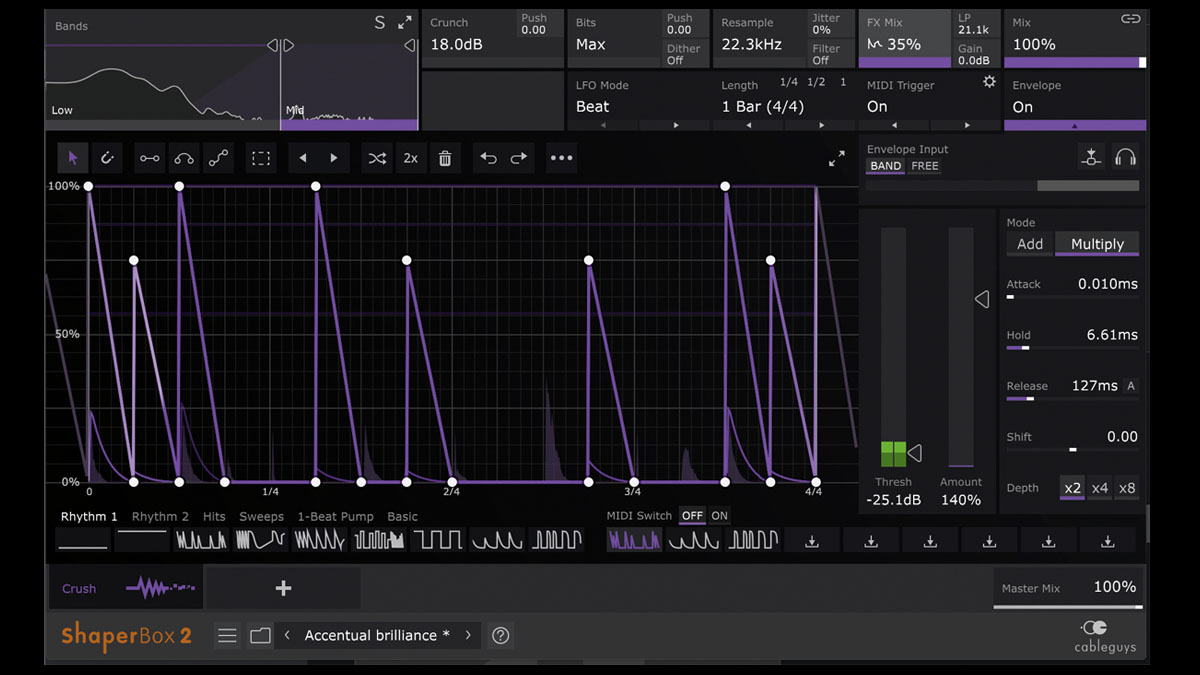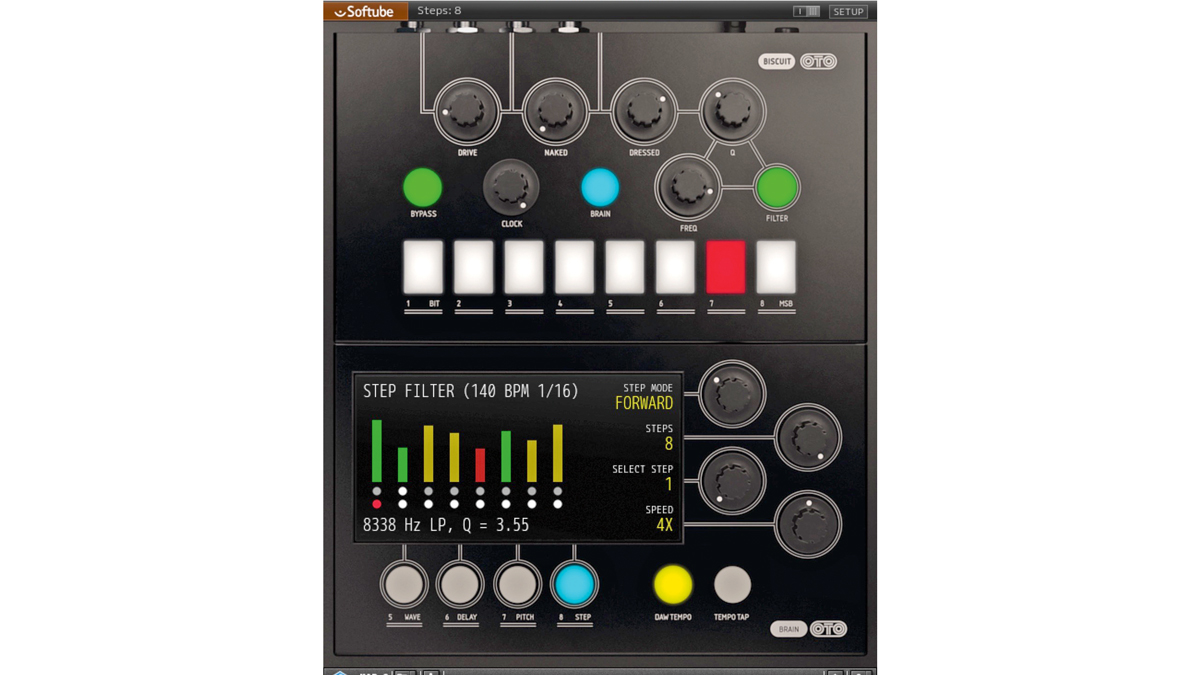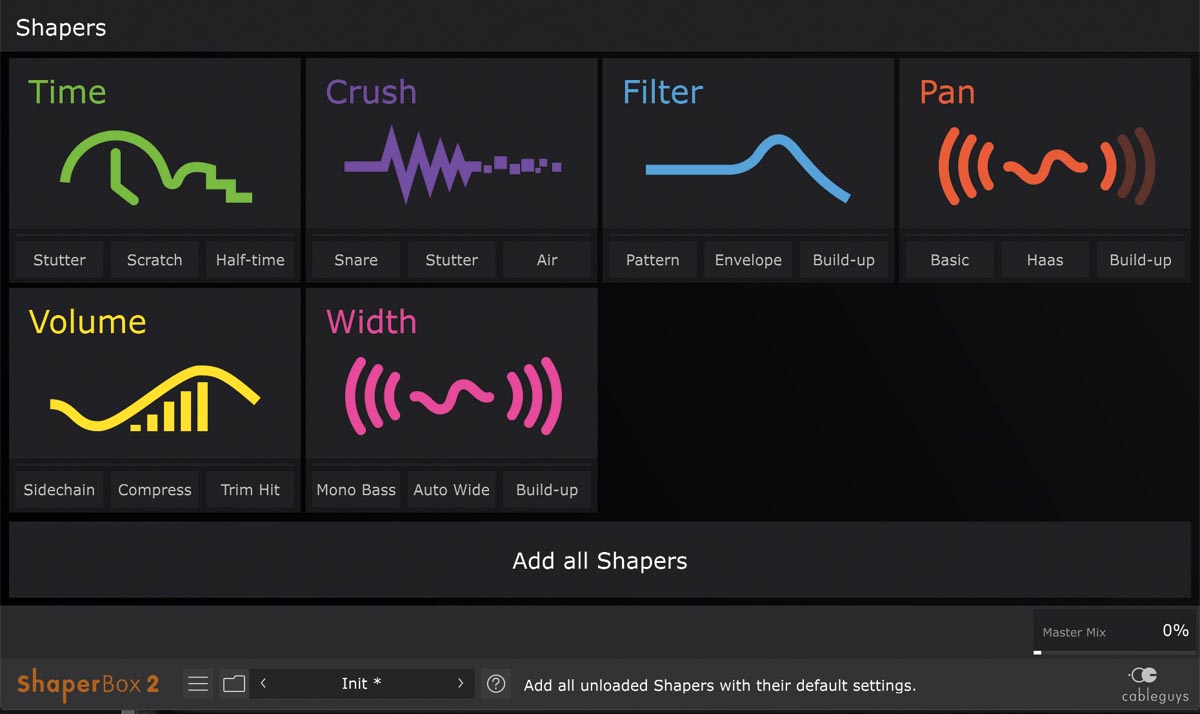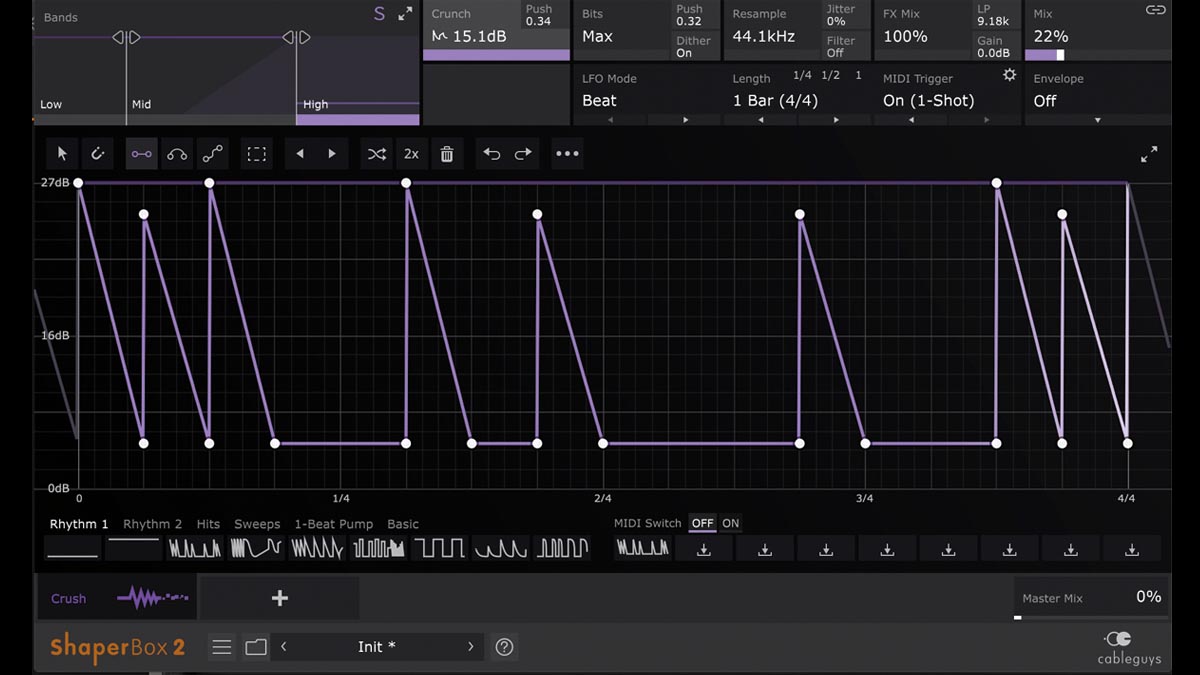MusicRadar Verdict
ShaperBox’s customisation tools make this a more powerful and nuanced take on the bitcrusher than any rival on the market right now.
Pros
- +
Subtle lo-fi to extreme destruction.
- +
Can be applied across three frequency bands independently.
- +
Drawing tools are easy to use.
Cons
- -
Stereo width or M/S control would be a nice touch.
MusicRadar's got your back
What is it?
CableGuys updated their modulation-focussed multi-effect tool ShaperBox towards the end of last year, and now the developers are adding a new processor into the mix.
CrushShaper is a bitcrusher designed to make use of the same customisable modulation tools as the rest of the ‘Shaper’ family. It runs within ShaperBox 2 and comes as part of the full ShaperBox bundle, but it’s also available as a standalone purchase.
Seasoned producers will, no doubt, be fully familiar with the general principles of bitcrushers. These digital distortion effects reduce the resolution and bandwidth of the target audio to achieve effects ranging from a subtle lo-fi quality to full-on destruction.
It’s a common effect, achievable via the stock plugins in most DAWs, so what does CableGuys’ take have to offer that others don’t?
CrushShaper is considerably more powerful than your average bitcrusher
CrushShaper is housed inside the same ShaperBox container as its sibling effects and, as with those tools, the emphasis here is on modulation as much as it is the effect itself. The UI’s focal point is the central grid in which users can shape their own custom LFO/envelope used to control the depth of the effect. ShaperBox itself offers an assortment of tools to make this possible.
There are pens, curve generators and a selection of editing tools that allow for deep, yet easy refinement of the automation curve.
However, there is also a selection of pre-designed curves that can act as a ready source of starting points. There’s plenty of control over the speed at which CrushShaper cycles through its modulation curves too. These can be sync’d to the project tempo at a host of different beat-divisions, set at a free-running Hz rate or set to track the pitch of incoming MIDI notes.

Performance and verdict
There are four different elements that can be modulated within CrushShaper. The first of these is a parameter labeled Crunch, which
CableGuys describe as ‘wave-wrapping distortion’ recreating the overflow effect of early digital gear. In practice this creates a digital ‘clipping’-like distortion effect that is especially prevalent in the mid-range. There is a parameter labeled Push here too, which introduces a DC offset (filtered out before the output) for asymmetrical distortion.

• Softube OTO Biscuit 8-Bit Effects
An emulation of the excellent, sequencer controlled hardware bitcrusher – a very creative effect.
• Native Instruments Crush Pack
A bargain bundle offering bitcrushing along with ring mod, overdrive and more.
The next element that can be modulated is Bits, which reduces the bitrate of the incoming audio from 16 down to 1-bit at its most extreme. Again, a Push parameter allows users to dial in a DC Offset here.
There’s also a simple on/off Dither switch for preserving the dynamic range of the original audio. Next to this is the Resample parameter, used for reducing the sample rate, and also controlled via a custom modulation curve.
CrushShaper is great for adding subtle elements of lo-fi character to a synth part, or punching up certain hits in a beat pattern
The range available here runs from 44.1kHz down to 8.82Hz. An adjustable Jitter parameter lets users add some unpredictability to the sample rate – replicating the unreliability of vintage digital gear – while an on/off low-pass filter can be used to reduce aliasing.
The final element controllable via modulation curve is a global FX Mix (ie dry/wet) parameter. This is in addition to the standard non-modulation-controlled Mix parameter, as well as ShaperBox’s overarching Master Mix control.
While having three independent dry/wet parameters might seem like an odd case of overkill, it’s actually very handy in practice.
Having a separate modulation-controlled Mix function means you can sequence the depth of all bitcrusher elements together making it easy to, say, apply extreme distortion to certain beats in a drum loop, or have things fade in and out for a drifting, Boards Of Canada-like lo-fi effect.
The addition of a separate static Mix means you can still have simple control over the wet/dry balance without needing to touch your carefully calibrated modulation. The FX Mix section also adds output gain and a low-pass for taming any harsh hi-frequencies. The Master Mix, finally, comes into play when more than one Shaper is being used within the plugin.

As with other ShaperBox devices, the flexibility of CrushShaper is expanded thanks to its ability to be applied separately across three frequency bands. As with sibling devices, these are set freely using a pair of slidable dividers, and, once designated, all parameters can be set and modulated separately for each of the low, mid and high bands.
All these factors combined make CrushShaper considerably more powerful than your average bitcrusher.
The effect itself is, in most cases, one that can get old rather quickly – heavy-handed use of digital lo-fi can sound a tad naff, particularly when applied across multiple track elements. CrushShaper’s ability to apply the effect precisely, and sparingly, makes it a much more nuanced and useful tool though. It’s great for, for instance, adding subtle elements of lo-fi character to a synth part, or punching up certain hits in a beat pattern.
In all, it’s a truly inspiring take on a common effect. Our only major criticism? We wish we could have a few extra distortion types to use with ShaperBox’s sequencing tools. DriveShaper can’t be too far behind, right? Come on CableGuys…
MusicRadar verdict: ShaperBox’s customisation tools make this a more powerful and nuanced take on the bitcrusher than any rival on the market right now.
The web says
"CrushShaper isn’t a bread-and-butter effect that you will turn to for every track. Like any digital degradation effect, it’s fair to say that this will be of most interest to those writing lo-fi and glitch style music. That said, it has opened our eyes to some new possibilities for using these effects in more subtle ways, to add texture to cleaner sounds."
MusicTech
Hands-on demos
ADSR Music Production Tutorials
CableGuys
Specifications
- Type: Rhythmic bitcrusher, vintage lo-fi, multiband enhancer effect plugin
- Key Features: 3 bitcrusher types (Crunch, Bits, Resample), Drawable LFOs, flexible envelope followers, dry/wet mix for each band, built-in help, dedicated selection tool for multinode editing, 2x/3x button for doubling/tripling patterns, flip/resize/move/randomize wave or selection, draggable parameters to shift the entire wave up/down
- System Requirements: Runs inside ShaperBox 2. Mac OS X 10.8 or later VST or AU host sequencer; Windows 7, 8 or 10 VST host sequencer 32- or 64-bit
- Contact: CableGuys
Computer Music magazine is the world’s best selling publication dedicated solely to making great music with your Mac or PC computer. Each issue it brings its lucky readers the best in cutting-edge tutorials, need-to-know, expert software reviews and even all the tools you actually need to make great music today, courtesy of our legendary CM Plugin Suite.
“Sometimes I am two people. Johnny is the nice one. Cash causes all the trouble. They fight”: How Johnny Cash drew on his own experiences to make his greatest songs
“For those on the hunt for a great quality 12-string electro-acoustic that won’t break the bank, it's a no-brainer”: Martin X Series Remastered D-X2E Brazilian 12-String review
“I have that on more records than anything else”: Take a peek inside Vaughn Oliver’s studio











